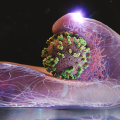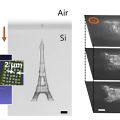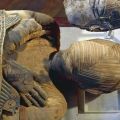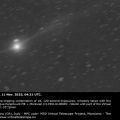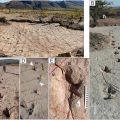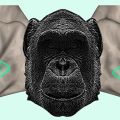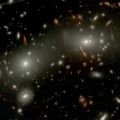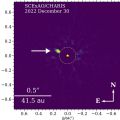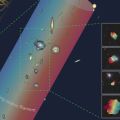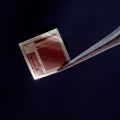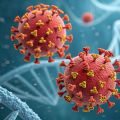Origine africaine de l'homme moderne - Définition
La liste des auteurs de cet article est disponible ici.
Reconstruction génétique
Modèle:See Deux éléments de la génétique humaine sont particulièrement utiles pour déchiffrer l'histoire de l'homme. L'un est l'ADN mitochondrial, et l'autre le chromosome Y. These are the only two parts of the genome that are not shuffled about by the evolutionary mechanisms which generate diversity with each generation. L'ADN mitochondrial et le chromosome Y sont donc transmis intacts de génération en génération. Sur la base de ces éléments, all 6.7 billion people alive today have inherited the same MitochondriaI think only few thousand pople get sequenced mtDNA, definietly no more than 100,000[citation nécessaire] from one woman who lived in Africa about 160,000 years ago; she has been named Eve mitochondriale. All men today have inherited their Y chromosomes from a man who lived 60,000 years ago, probably in Africa. He has been named Y-chromosomal Adam. It is now believed that more men participated in the out of Africa exodus of early humans than women based on comparing non-gender specific chromosomes with gender specific ones.
ADN mitochondrial
Modèle:See
Le premier lignage à se séparer du plus récent ancêtre matrilinéaire commun, encore appelé "Eve mitochondriale", est L0. Cet haplogroupe se trouve en proportions élevées parmi les San d'Afrique australe et les Sandawe de Tanzanie. On trouve L1 chez les Pygmées Binga Les macro haplogroupes M et N, qui sont les lignages du reste du monde en dehors de l'Afrique, descendent du L3.
ADN Y-chromosomal
The mutations defining macro-haplogroup CT (all Y haplogroups except A and B) predate the "Out of Africa" migration, its descendent macro-group DE being confined to Africa. The mutations that distinguish Haplogroup C from all other descendants of CR have occurred some 60,000 years ago, shortly after the first Out of Africa migration.
Haplogroup F originated some 45,000 years ago, either in North Africa (in which case it would point to a second wave of out-of-Africa migration) or in South Asia. More than 90% of males not native to Africa are descended in direct male line from the first bearer of haplogroup F.
Analyse du génome
Although mitochondrial DNA and Y-chromosomal DNA are particularly useful in deciphering human history, data on the genomes of dozens of population groups have also been studied. In June 2009, an analysis of genome-wide SNP data from the International HapMap Project (Phase II) and CEPH Human Genome Diversity Panel samples was published. Those samples were taken from 1138 unrelated individuals. Before this analysis, population geneticists expected to find dramatic differences among ethnic groups, with derived alleles shared among such groups but uncommon or nonexistent in other groups. Instead the study of 53 populations taken from the HapMap and CEPH data revealed that the population groups studied fell into just three genetic groups: Africans, Eurasians (which includes natives of Europe and the Middle East, and Southwest Asians east to present-day Pakistan), and East Asians, which includes natives of Asia, Japan, Southeast Asia, the Americas, and Oceania. The study determined that most ethnic group differences can be attributed to genetic drift, with modern African populations having greater genetic diversity than the other two genetic groups, and modern Eurasians somewhat more than modern East Asians. The study suggested that natural selection may shape the human genome much more slowly than previously thought, with factors such as migration within and among continents more heavily influencing the distribution of genetic variations.
Premiers Homo sapiens
L'homme moderne est apparu en Afrique il y a environ 250 000 ans. La tendance à l'expansion de la boîte crânienne ainsi que le développement de l'industrie lithique de l'Acheuléen qui se sont produit entre 400 000 ans avant le présent et la seconde période interglaciaire du Pléistocène Moyen, il y a environ 250 000 ans, témoignent de la transition de H. erectus vers H. sapiens. Dans le scénario de l'origine africaine de l'homme moderne, les migrations d'H. sapiens à l'intérieur et depuis l'Afrique ont progressivement remplacé les populations d'H. erectus qui les avaient précédées sur cette voie.
Homo sapiens idaltu trouvé sur le site de Middle Awash en Éthiopie vivait il y a environ 160 000 ans. It is the oldest known anatomically modern human and classified as extinct subspeciesModèle:Clarify. Fossils of modern humans were found in Qafzeh cave in Israël and have been dated to 100,000 years ago. However these humans seem to have either gone extinct or retreated back to Africa 70,000 to 80,000 years ago, possibly replaced by south bound Neanderthals escaping the colder regions of ice age Europe.[citation nécessaire] Hua Liu & al. analyzing autosomal microsatellite markers dates to c. 56,000±5,700 years ago mtDNA evidence. The paleontological fossil of early modern human from Qafzeh cave dated at 80,000–100,000 Liu interpret as isolated early offshoot that retracted back to Africa.
All other fossils of fully modern humans outside of Africa have been dated to more recent times(80,000–100,000 year ago). The next oldest fossil of modern humans outside of Africa are those de l' l'Homme de Mungo et have been dated to about 42,000 years ago.
Beginning about 100,000 years ago evidence of more sophisticated technology and artwork begins to emerge and by 50,000 years ago fully modern behaviour becomes more prominent. By this time the ritual burying of the dead is notedwhere[citation nécessaire]. Stone tools show regular patterns that are reproduced or duplicated with more precisionwhere[citation nécessaire]. Tools made of bone and antler appear for the first timewhere[citation nécessaire].








